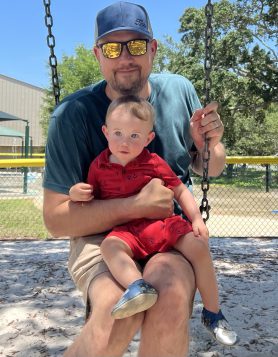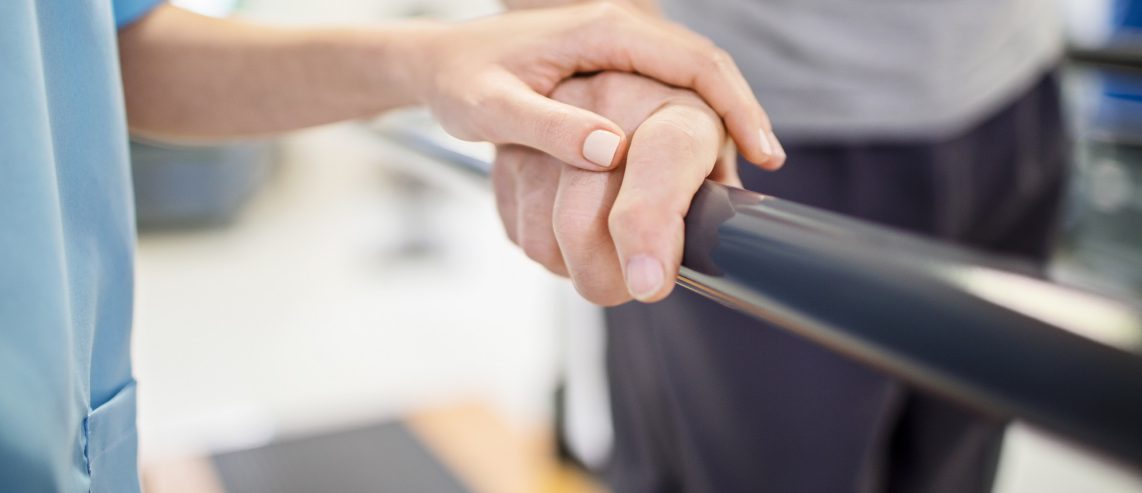Andrew, 35, and his wife were looking forward to the imminent birth of their first child in April 2022 when he collapsed in a seizure onto the floor of his Hampton Township home. Tests showed a ruptured aneurysm and severe bleeding in the brain.
Andrew spent weeks in a coma as his medical team at UPMC Presbyterian worked feverishly to stabilize him. He had multiple surgeries and was placed on a ventilator. Eventually, he was finally able to meet his 3-week-old son, Willy, after he was transferred to the brain injury unit at UPMC Mercy to begin inpatient therapy with UPMC Rehabilitation Institute.
At the time, he couldn’t walk, talk, swallow, or breathe on his own.
Never Miss a Beat!
Subscribe to Our HealthBeat Newsletter!
Thank you for subscribing!
You can now select the specific newsletters you'd like to receive.
You are already subscribed.
Subscribe to more newsletters in our email preference center.
Sorry, an error occurred. Please try again later.
Get Healthy Tips Sent to Your Phone!
The Challenge: Overcoming a Devastating Loss of Function, Setbacks
Although he was glad to be alive, Andrew initially didn’t have high expectations for his recovery.
“I didn’t expect to walk again. In my mind, I had to adapt to my new reality: being confined to a wheelchair and unable to communicate in the same way I did before,” says Andrew, a program manager for a tech startup company. “Luckily, I had some really good therapists who wouldn’t accept that and pushed me to get better.”
By the time he left UPMC Mercy five weeks later, Andrew could stand and was close to walking. Unfortunately, he was back in the hospital a week later for gallbladder surgery, then needed a neurosurgery procedure to place a shunt to drain fluid from his brain.
“That set me back,” says Andrew.
Big Strides with Intensive Outpatient Therapy
 In fall 2022, Andrew finally began intensive outpatient therapy, working twice a week with neurologic and vestibular physical therapist Helena Pingree, DPT, at UPMC Rehabilitation Institute — initially in Allison Park, then at the Cranberry Township location. He also had weekly outpatient occupational therapy focused on regaining the use of his hands.
In fall 2022, Andrew finally began intensive outpatient therapy, working twice a week with neurologic and vestibular physical therapist Helena Pingree, DPT, at UPMC Rehabilitation Institute — initially in Allison Park, then at the Cranberry Township location. He also had weekly outpatient occupational therapy focused on regaining the use of his hands.
“When I started working with Helena, I was wheelchair-bound. I could only take three steps with two people helping me,” says Andrew. “My goal was to walk independently again and be able to hold my son.”
Andrew had big challenges to overcome. In addition to extreme weakness in his arms and legs, he had poor control of his body due to brain damage caused by the ruptured aneurysm, according to Helena.
She developed a therapy program focusing on exercises to promote neuroplasticity — the brain’s ability to change and adapt through experience. To do that, she introduced high-intensity gait training, which included walking and stepping at a vigorous enough pace to keep Andrew’s heart rate at a target level. To create imbalance and retrain his brain, Helena added various exercises and tasks.
Throughout his therapy, she also carefully monitored his blood pressure and heart rate to ensure the exercises were intense — but not overly taxing or harmful.
“I would challenge Andrew enough to nearly make him fall, but in a safe way, so he could relearn how to correct a loss of balance,” explains Helena. “By introducing that error, combined with higher-intensity training, Andrew was able to learn how to control his arms, legs, posture, and balance again.”
Partners in Therapy
Throughout his outpatient therapy program, Helena carefully explained each exercise so Andrew would understand the purpose of the movements and challenges. They also worked together to identify goals and troubleshoot problems.
“Each time he came in, I would ask: What are you having the most trouble with? What are the day-to-day things you are struggling with?’” says Helena. “We would problem solve together so I could tailor my treatment goals to his goals. He would meet the goals and I’d set new ones.”
With a baby at home, Helena created an “obstacle course” for him to practice stepping over and around toys and other items. Because Andrew wanted to go on walks with his family, she created uneven surfaces for him to negotiate and had him wear a weighted vest and leg weights. She also gave him exercises to do at home.
“Helena always did a really good job of explaining why she approached a problem in a certain way. It was very educational,” says Andrew. “Outpatient therapy was great. I would go in and, afterwards, I would see immediate results.”
“Because of the care I received, I was able to eventually walk independently with a cane. That opened so many doors for me and set me up for my future recovery.”
Like Father, Like Son
Andrew continued his UPMC rehabilitation program through April 2023 — a full year after his stroke. As he progressed, he realized – to his amusement – that he and Willy were developing at the same pace.
“When Willy learned to roll over, I was learning to roll over. When I started walking, he started walking that same week,” says Andrew.
“It’s been interesting to see the development and understand the frustrations that Willy is going through when he’s unable to do something he wants to do. I think I understand that a little better than most parents.”
In May, Andrew and his family moved to a new home in Florida, where he doesn’t have to deal with cold, snowy weather or western Pennsylvania’s hills. He now takes daily walks around their neighborhood — a half mile in just 18 minutes — using a single hiking pole.
“I was fortunate to get the care I needed at UPMC,” says Andrew. “They helped me figure out how to walk again, which was huge.”
Helena gives the credit to Andrew. “He is such a great success story because he knew what he needed to do and he was such a hard worker,” she says. “We educated him on all the pieces to the puzzle and Andrew did everything we asked him to do.”
For more information about outpatient therapy at UPMC Rehabilitation Institute, call 1-888-723-4277.
About UPMC Rehabilitation Institute
The UPMC Rehabilitation Institute offers inpatient, outpatient, and transitional rehabilitation, as well as outpatient physician services so that care is available to meet the needs of our patients at each phase of the recovery process. Renowned physiatrists from the University of Pittsburgh Department of Physical Medicine and Rehabilitation, as well as highly trained physical, occupational, and speech therapists, provide individualized care in 12 inpatient units within acute care hospitals and over 80 outpatient locations close to home and work.
